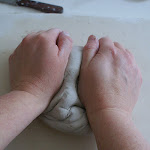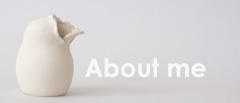 My big mini mini friend Heli wrote a blogpost about whirling Derwishes.
My big mini mini friend Heli wrote a blogpost about whirling Derwishes.It reminded me of a work I made in the academy of fine arts a few years ago.
The assignment was: 'design a series of forms which have an axis as a base'. A challenge because when you give it thought, there are many things that swirl around their axis. Look at nature: a tornado, the moon, fruits, seeds,... For me, that was too obvious and I took my time to think about the assignment a bit longer. A second assignment was: 'build a form in where light and darkness play an important role'. Use folds and pleads of paper as an example. Why shouldn't I combine the two assignments? I looked for a material in which I could express my idea. Quickly I realised that liquid china clay was the solution to design the whirling derwisjes that were in my mind. A whole year I have been experimenting with different recipes and I enjoyed seeing the various results. The liquid china clay had to be very white and needed to have enough strength to stand alone after firing the clay. I drenched normal tissue paper in the liquid china clay and draped them onto conical, ceramic moulds covered with plastic foil. When they were dry, I extricated the form from the mould and fired them in the ceramic oven at 1250°C. The tissue paper burnt away, but the shape of the draped tissue stayed because of the china clay
I wanted to show the process of ecstacy because that would make it obvious that it is more than swirling around the axis. That's why I chose for rising derwisjes who are about to reach the state of ecstacy and to return in a descending way back to earth. The way they have been exposed shows the movement in this work. If you concentrate on the derwisjes and the drapes, you can see them swirl around their axis.
An extra touch to this work is the light I have put inside the derwisjes. When the light is on, the drapages of the derwisjes shine beautifully through the semi-transparante china clay.
I wanted to show the process of ecstacy because that would make it obvious that it is more than swirling around the axis. That's why I chose for rising derwisjes who are about to reach the state of ecstacy and to return in a descending way back to earth. The way they have been exposed shows the movement in this work. If you concentrate on the derwisjes and the drapes, you can see them swirl around their axis.
An extra touch to this work is the light I have put inside the derwisjes. When the light is on, the drapages of the derwisjes shine beautifully through the semi-transparante china clay.

The derwisjes are a forbidden outgrowth in Muslim religion. The ceremony is a ritual dance which represents the alliance with Allah. The derwisjes wear long, white dresses which represent their shroud. On top of that, they wear big, black coats which represent their worldly tombs. The long conical, red felt hats are representing their tombstones.A male chorus and an orchestra starts the music. The derwisjes unfold their arms and start swirling. They turn their right palm upwards to receive energy from Allah through their body and via the left palm, which is turned towards the earth, they release the enery to earth. They throw their black coats off and reach an ecstacy with a heavenly expression.The breathing, torturing music of the flute is the most sensational sound during the ceremony.









